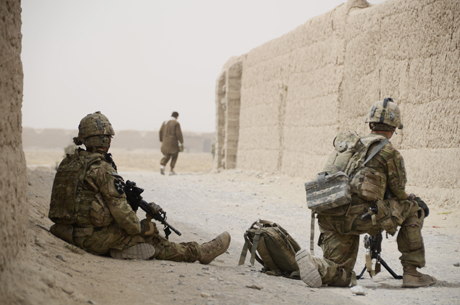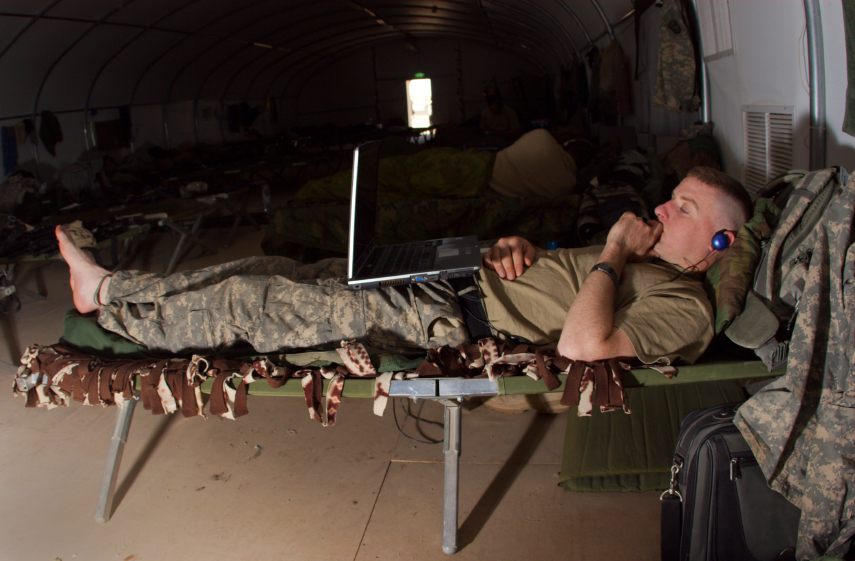Mild Traumatic Brain Injury and Deployment Associated with Inflammatory Abnormalities in Veterans of the Iraq and Afghanistan Wars
Mild traumatic brain injury from improvised explosive devices is an injury particular to veterans of the wars in Iraq and Afghanistan. As has been seen in some athletes who sustain repeated mild traumatic brain injuries, such as boxers and football players, neurodegenerative dementias such as chronic traumatic encephalopathy can follow these repeated brain injuries. Researchers are hoping to identify biomarkers that would help in the diagnosis and monitoring of repeated blast-induced mild traumatic brain injury. Researcher Elaine Peskind and colleagues have determined that both deployment to these wars and mild traumatic brain injuries received there are associated with increased inflammatory cytokines in cerebrospinal fluid.
In the study, veterans who had been deployed to Iraq or Afghanistan and had received mild traumatic brain injuries were compared to veterans who were deployed but who were not similarly injured and community participants who had neither been deployed nor experienced a brain injury. The average number of concussion-inducing blasts veterans in the first group had experienced was 14, with the latest occurring an average of four years prior to the study.
Inflammatory cytokine IL-7 was elevated in the spinal fluid of those veterans who had sustained brain injuries. IL-6 was higher both in those deployed and in those who sustained blasts. Eotaxin and granulocyte colony stimulating factor were higher in all of the veterans who had been deployed.
These cytokine abnormalities could account for behavior and cognitive difficulties associated with traumatic brain injury. The researchers concluded that both deployment and mild traumatic brain injury were associated with neural damage and neuroimmune responses.
Editor’s Note: Michael E. Hoffer et al. reported in the journal PLosOne in 2013 that veterans with blast-induced mild traumatic brain injury had a better acute outcome when they were given the antioxidant N-acetylcysteine (NAC) within the first 24 hours after the trauma. It is interesting to speculate whether this could be explained by NAC’s anti-inflammatory effects, its enhancement of another antioxidant (glutathione), or its ability to increase glial glutamate transporters.
Researcher Dewleen Baker reported in a personal communication to this editor (Robert Post) that in her patients, traumatic brain injury was also associated with white matter abnormalities, and that these injuries conveyed an increased risk of developing PTSD as well.
A Paradigm for Treatment of Severe PTSD developed by Dr. David Bakish
In an earlier BNN we mistakenly attributed the protocol developed by David Bakish, a renowned Canadian psychopharmacologist, to another doctor named Vaishali P. Bakshi. Our apologies to both individuals.
Dr. David Bakish is Medical Director at the Ottawa Psychopharmacology Clinic and a Former Professor of Psychiatry at the University of Ottawa in Ottawa, Ontario. He shared with this editor his novel treatment strategy for patients with exceptionally profound degrees of post-traumatic stress disorder (PTSD), which, particularly among military veterans, can be compounded by traumatic brain injury. He has had a distinguished academic career with an extensive CV and credentials including membership in the International College of Neuropsychopharmacology (CINP), the Royal College of Physicians and Surgeons of Canada, and the Canadian and European Colleges of Neuropsychopharmacology. Most importantly he has had great success in treating large numbers of patients with severe PTSD. Treatment options based on placebo-controlled clinical trials are sometimes insufficient for the treatment of seriously ill patients. FDA-approved treatment for PTSD consists of serotonin-selective antidepressants, while exposure therapies (in which the patient is gradually exposed to more of the stimuli that triggered symptoms) are the recommended psychotherapy, but these methods often leave patients highly disabled. We relay Dr. Bakish’s treatment strategy with several caveats.
Most of Bakish’s suggestions are “off-label” treatments for the treatment of PTSD or traumatic brain injury, i.e. treatments that are not FDA-approved for these purposes. In some of these instances, there is no controlled research to support the use of these drugs in patients with PTSD. Thus the ideas noted here are anecdotal, based on his personal experience, and have not been tested in controlled clinical trials. Accordingly, patients with their physicians must make their own decisions about any of the strategies reported in this or other issues of the BNN.
Bakish’s typical treatment algorithm goes well beyond the usual treatment guidelines to find solutions for hard-to-treat patients. Bakish first addresses sleep disturbance, which is almost universal in PTSD. He suggests the anticonvulsant levetiracetam (Keppra), for the hyperarousal and sleep disorder. He uses starting at doses of 125mg per night and increases by 125mg every three weeks. Read more
Resilience Important for Mental Health
A symposium at the 2014 meeting of the American Psychiatric Association suggested that resilience may hold the key to healthy aging, and overcoming trauma and stress.
Resilience in Aging
Former APA president Dilip Jeste began the symposium with a discussion of successful aging. He noted the importance of optimism, social engagement, and wisdom (or healthy social attitudes) in aging. In a group of 83-year-olds, those with an optimistic attitude had fewer cardiovascular illnesses, less cancer, fewer pain syndromes, and lived longer. Those with high degrees of social engagement had a 50% increase in survival rate. Wisdom comprises skills such as seeing aging in a positive light, and having a memory that is biased toward the positive (the opposite of what happens in depression, where negatives are selectively recalled and remembered). Jeste encouraged psychiatrists to focus not just on the treatment of mental illness, but on behavioral change and the enhancement of wellbeing. He suggested asking patients not just, “How do you feel?” but instead, “How do you want to feel?”
Resilience in the Military
Researcher Dennis Charney gave a talk on resilience based on his work with people in the military, some of whom experienced post-traumatic stress disorder (PTSD). He cited a series of important principles that could enhance resilience. The first principle was to reframe adversity—assimilating, accepting and recovering from it. The second principle was that failure is essential to growth. The third principle was that altruism helps, as does a mission for the survivor of trauma. Charney suggested that a personal moral compass is also critical, whether this is based on religion or general moral principles. Other factors that are important for resilience include having a role model, facing one’s fears, developing coping skills, having a support network, increasing physical well-being, and training regularly and rigorously in multiple areas.
Charney and colleagues studied Navy SEALS who went through SERE (Survival, Evasion, Resistance, Escape) training. Those SEALS who had the highest resilience during this severe training exercise had the highest levels of the neurotransmitter norepinephrine and NPY (an antianxiety neuropeptide). NPY levels are low in people with PTSD. Charney and colleagues reasoned that giving a peptide that acted on the NPY-1 receptors intranasally (so that it could cross the blood brain barrier) might be therapeutic. In a rodent model of PTSD, the peptide prevented and reversed PTSD-like behaviors. Further clinical development of the peptide is now planned.
The Effects of Stress
Researcher Owen Wolkowitz described how stress accelerates the mental and physical aspects of aging. Telomeres are strands of DNA at the end of each chromosome that protect the DNA during each cell replication. Telomere length decreases with stress and aging. Read more




